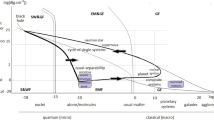Abstract
The second virial coefficients of homonuclear three-centerLennard-Jones molecules are calculated with various parameters of the isosceles triangle connecting the three sites. A special effort is made to establish the reducedBoyle temperaturesT B and the values of the second virial coefficients atT/T B=0.3 for the sake of comparison with one- and two-centerLennard-Jones molecules. It is shown that it is possible to find parameter values of the interaction potential of one- and two-centerLennard-Jones molecules which give very similar values of second virial coefficients forT/T B≥0.3, and the equivalence conditions are established. These conditions might not only give a basis for a microscopic scaling of state variables, but also some restrictions for the validity of the group contribution concept.
Zusammenfassung
Es wird der zweite Virialkoeffizient homonuklearer Drei-ZentrenLennard-Jones Moleküle angegeben, und zwar für verschiedene Parameter des gleichschenkligen Dreiecks, welches die Zentren verbindet. Besonderes Gewicht ist auf die Ausrechnung der reduziertenBoyle-TemperaturT B und auf die Werte des zweiten Virialkoeffizienten beiT/T B=0.3 gelegt, welche zum Vergleich mit Ein-und Zwei-ZentrenLennard-Jones Molekülen herangezogen werden. Es wird gezeigt, da\ für Ein- und Zwei-ZentrenLennard-Jones Moleküle Parameter des Wechselwirkungspotentials gefunden werden können, welche sehr ähnliche Werte für die zweiten Virialkoeffizienten für TemperaturenT/T B≥0.3 ergeben; diese Äquivalenzbeziehungen werden angegeben. Diese Bedingungen geben einerseits einen Hinweis auf die mikroskopische Skalierung der Zustandsvariablen, andererseits deuten sie auf Gültigkeitsgrenzen des Gruppenbeitrags-Konzepts.
Similar content being viewed by others
References
Kohler F., Quirke N., in Molecular-Based Study of Fluids (Haile J. M., Mansoori G. A., eds.), Advances in Chemistry Series Nr. 204. Washington, D.C.: American Chemical Society. 1983.
Maitland G. C., Rigby M., Smith E. B., Wakeham W. A., Intermolecular Forces. Oxford: Clarendon Press. 1981.
Fischer J., Lustig R., Breitenfelder-Manske H., Lemming W., Molec. Phys.52, 485 (1984).
Kerl K., Häusler H., Bunsenges. Phys. Chem.88, 992 (1984).
Lustig R., to be published.
Conroy H., J. Chem. Phys.47, 5307 (1967).
Boublik T., Nezbeda I., Chem. Phys. Letters46, 315 (1977).
Rowlinson J. S., Molec. Phys.6, 515 (1963).
Powell M. J. D., Molec. Phys.7, 591 (1964).
Lustig R., submitted to Molec. Phys.
Wojcik M., Gubbins K. E., Powles J. G., Molec. Phys.45, 1209 (1982).
Author information
Authors and Affiliations
Rights and permissions
About this article
Cite this article
Breitenfelder-Manske, H., Kohler, F. The second virial coefficient of 3-centerLennard-Jones molecules and its relation to 1- and 2- center molecules. Monatsh Chem 116, 1247–1261 (1985). https://doi.org/10.1007/BF00811097
Received:
Accepted:
Issue Date:
DOI: https://doi.org/10.1007/BF00811097




